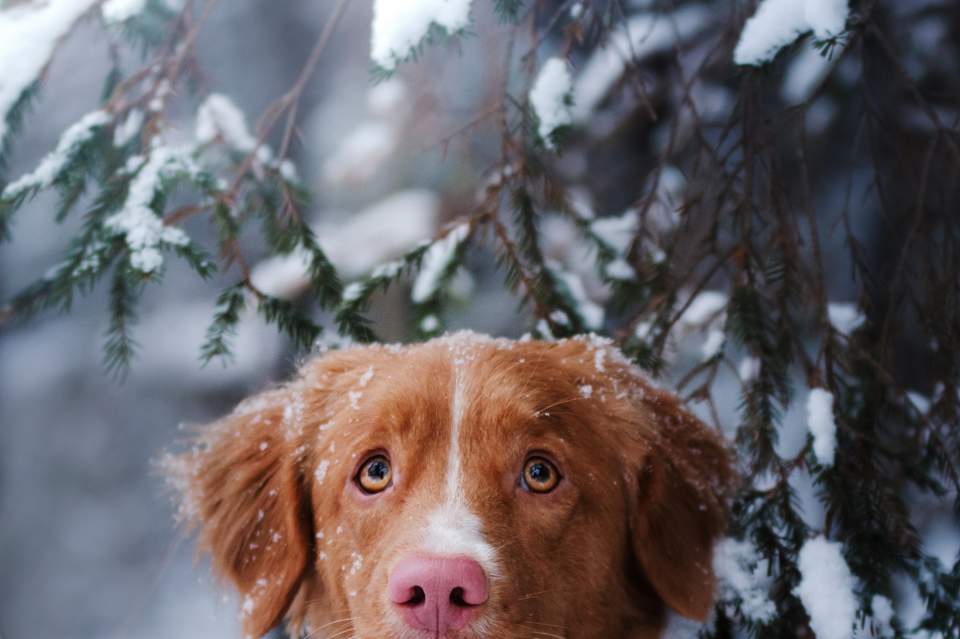
10 Tips for Winterizing your Pet

“Winterizing” in warm climates isn’t all that involved — clean the gutters, replace vehicle wiper blades, turn the thermostat up to 76 and remember to bring a sweater and umbrella just in case.
There. Done! And it’s just as easy for our pets.
For cold climates with actual weather, like wind, rain, sleet, snow, and ice, preparations are a little more intense — not just for our homes and us, but for our pets.
This is where we need real winterization, and it’s not something to take lightly. the groundhog isn’t going to tell us how the weather is going to be on February 2. When midwinter comes around, the groundhog can only tell us, “Saw my shadow, six more weeks of winter,” or “Didn’t see it, early spring.”
The problem is that there’s no choice for, “Oops — it’s going to be winter until May,” which is entirely possible nowadays. This is why we should rely on planning ahead from what we know and not the whims of large burrowing rodents of the squirrel family.
Areas to prepare
One of the main ways humans winterize is by changing our wardrobes. It’s no longer time for those thin summer slacks and skirts, shorts, Ts and tank-tops. Now it’s time for heavy pants, maybe pantsuits instead of skirts or dresses, thermal undies, insulating jackets, toques, or other headgear, and gloves or mittens.
We may also need heavy, water-proof boots or overshoes for particularly cold, snowy weather. At the very least, we need thick shoes with textured soles that can grip. This is not the time for those smooth-soled dress shoes that look good but turn into ice skates without brakes as soon as you hit anything wet or snowy.
This is how you wind up in a video online.
Yes, there do seem to be those people who can go outside in 10°F wearing shorts and a tank top and not even notice or care, but they are few and far between. And humans have to wear clothes anyway. Dogs and cats don’t. So do we need to wrap them up?
When it comes to our pets, things we need to concern ourselves with when winter comes are grooming, diet, safety, warmth, and life at home. But before we look at those specifics, there are a few important questions to ask that all center around your pet.
Your winter check-list
First: Is my pet’s breed suited to the cold or not? If you have a huskie or Malamute or other working dog famous for pulling sleds, then you have a dog made for winter. On the other hand, certain breeds — particularly smaller dogs with shorter coats — don’t handle winter or cold weather all that well.
These include Chihuahuas, greyhounds, Yorkies, whippets, and Chinese crested. Perhaps surprisingly, other breeds that don’t tolerate cold well are French bulldogs, basset hounds, Doberman pinschers, and pit bulls.
You can look up specifics on your own breed to find out, and the same goes for cats.
Second: Is my pet indoor or outdoor? For cat people, trick question: Your cat should never be an outdoor pet unless it’s a feral animal you found that way that you can’t bring inside. Outdoor cats tend to not live long. They also decimate local wildlife at the very least — and a lot of cats kill a lot more than one-tenth of the local wildlife.
Most outdoor dogs don’t have the same free rein as cats, so they’ll have a doghouse and a yard to run in, unless it’s on a larger rural property like a family farm. If your pet is an outdoor pet, then you need to consider whether you can provide something outside, like a fully-insulated, heated doghouse and heated water bowls to keep your dog safe, or whether it’s best to bring them inside.
Always bring the cat inside.
Third: How old is my pet, and how is their general health? If they have any kind of mobility problems due to conditions like hip-dysplasia or arthritis, you’ll need to take extra precautions to help them navigate wet sidewalks and snowy or icy ground. They may have other conditions that make them extra sensitive to cold, and these often come with age.
No, your elderly relative is not going crazy when they insist that 80°F inside is freezing. To them, it really is, and your dog or cat may have the same reaction; they just can’t tell you as directly.
In any case, check with your vet, and be sure to specify that you’d like to know how tolerant or not your pet is going to be to cold weather and what you can do to make them more comfortable.
As always, the rule is: “Know your pet.” It’s your responsibility to be aware of their limitations and needs so that you can plan ahead to provide for them.
So how do you plan? Here are our ten tips.
How to winterize your pet
1. Bathe less but groom more
In winter months, you’ll want to bathe your pets less often because the cold air cannot hold as much water, so they will dry more slowly. Washing too often can also remove protective oil from their skin. This is not good in dry weather, which comes just as much with extreme cold as it does extreme heat.
Don’t shave your pet’s coat but do trim long hair to prevent things like ice or outdoor deicing chemicals from clinging. And do brush your dog’s fur frequently. Brushing out their fur helps keep them warmer by eliminated clumpy, matted fur, which is not as good an insulator.
If your dog refuses to wear booties to go on walks, do trim the hair between the pads on their feet so it won’t hold ice, and use a protective balm. Clean and dry their feet first when they are coming inside to remove ice, dirt, mud, salt, or deicers.
2. Adjust their diet
If you have an outdoor dog who is very active, then winter is actually the time to feed them a little bit more, but otherwise for indoor pets (and people) who are less active, it’s obviously time to cut down on the daily caloric intake. When your indoor pets do play strenuously outdoors, give them some extra treats at that time, too.
Also, if your pets are wearing extra layers to keep warm, remember that this means they’ll need extra water to stay hydrated. And, of course, the same thing is true for us.
3. Keep them safe from chemicals
This is the time of year when people use deicers or salt their drives and walkways to thaw out ice and snow. Although ordinary rock salt is the most common product used in deicing because it’s cheap (it’s the same as table salt), a lot of other chemicals are used as well because they do the same thing: Lower the temperature at which water freezes, turning ice into water, breaking bonds with roads, pavements, and so on.
It’s the same theory a hand-cranked ice-cream maker works on, with the rock salt and ice water outside of the mixing chamber lowering the temperature to ice-cream friendly levels.
Make it a point to find out what your neighbors are using as well as checking with your local municipality or HOA to find out what they’re spraying everywhere. This will help you to protect your dog from the chemicals and know when those booties are a necessity, no matter how your dog feels about them.
4. Know your pet’s needs

We mention it above, but not every dog or cat is suited for the cold. If your pet needs to be bundled up, fit them for their warm-weather gear early, then give them time to get used to its smells and feel before setting it on them (not putting it on yet) so that they are completely used to it. It’s very similar to getting them used to wearing a Halloween costume, actually.
Pet clothing for winter can be just as varied as human clothing, ranging from thick but non-restricting vests and sweaters to full-body onesies with or without hoods to heavy jackets that a human would feel toasty skiing in.
As for footwear, this also covers a range from knitted booties with rubber soles designed mostly for warmth and traction to more boot-like and structured footwear designed to protect from snow, ice, salt, and other hazards.
If your cat or dog has never really worn any kind of shoes or socks, these will definitely take some getting used to on their part. As with anything else, it’s a gradual process of getting acclimated with a combination of patience and treats.
Don’t be surprised, though, if the first time you get all four winter shoes on your dog or especially your cat that they start prancing like a Lipizzaner stallion during a show at the Spanish riding school in Vienna. This high-stepping is their natural reaction to something unusual on their feet, but they’ll eventually stop.
5. Leash ‘em if you love ‘em — especially in snow
It may seem like a dog or cat might not be able to get too far or get into too much trouble when there’s deep, powdery snow, making it tempting to let them off-leash to play, but outside of a safely enclosed area, this is exactly the wrong thing to do, especially if you have a white or cream-colored pet.
Even if they’re leaving a trail in the snow, they can wind up creating a snow-maze, doubling back, and getting out of your sight. And you’re not the only one who will have a problem “seeing” them against the snow.
The combination of cold weather and dry air also means that scents do not hang around like they normally do, effectively making your cat or especially dog blind as well. They won’t be able to pick up on those familiar clues to find their way back to you or to home, making it much likelier for them to panic and start running whichever way they think they should be going.
This is how so many pets get lost each year, snow or not. They get out, wind up in an unfamiliar place, then start running for “home” as fast as they can, whether they’re going the right way or not. Sometimes, they can wind up miles away and lost.
This is why you should always, always have your pets on a sturdy leash when you take them out into the snow. Avoid any kind of variable-length lead and use a strong six-foot fixed leash. Check the metal parts regularly for signs of corrosion or rust.
When choosing a winter lead, though, there’s one other very important consideration, but it goes beyond just the leash, so it’s a separate point.
6. Reflect on safety
The leash, along with your dog’s collar, any kind of harness or outer wear, and the booties should be a bright neon color and marked with reflective material — preferably emergency orange or yellow You should have the same kind of color and markings on your coat, pants, headgear, and gloves as well.
This is all to make you both stand out against the white snow and be highly visible not just to each other, but to any other people or traffic approaching in what can often be low-visibility conditions. Of course, if you walk your dog after dark all the time, these things should already be a part of your regular wardrobes.
They are doubly important in snowy conditions in winter.
7. Stay away from frozen lakes and ponds
These may be favorite play spots for you and your dogs in summer, especially if there are waterfowl around for your dog’s amusement — not for hunting, though!
Your dog may even be the type to jump right into the water on a hot summer’s day and splash around a bit. This is all fine if the water is relatively clear of plants or moss or generally clean, but all bets are off in winter, especially when those lakes and ponds freeze over.
Here’s the thing about ice on water: We never have anyway of really knowing how thick it is except in very exceptional circumstances where the ice freezes crystal clear and you can see the thickness at an angle. Otherwise, that “frozen” lake could have a very still quarter inch of ice on it that will immediately shatter if stepped on or a quite deceptive thicker layer of ice that will hold up for a while if walked on until it doesn’t hold up or you come to a thinner spot.
Suddenly falling into frigid water that might even be below 32°F (0°C) will be a big shock to you and your dog with the immediate instinct on both your parts to get out. But, of course, if you’ve gone out far enough into the body of water, the only surface you have to pull yourself up on is the same ice that just broke.
You also don’t have all that long in water so cold — go rewatch the ending of Titanic for reference. And if it’s salt water, just like with the ice cream maker, it will be below freezing as well.
Worst of all though are snow drifts that can cover over ice at the edges of bodies of water, and since these have an insulating effect, then can warm the ice up — not quite enough to melt it, but certainly to thin it out. It creates a deceptive trap that looks like snow on solid ground but isn’t.
Before you go out, know where the edges of your local water features are supposed to be, then stay well clear of them or, safest of all, go to different locations until everything thaws in the spring.
8. When in doubt, leave your pets at home
It’s the same rule year-round: If the weather is too hot (or cold), do not take your dog or cat if you’ll have to leave them in the car at any point, no matter how briefly. This is equally true for winter and summer. A closed car in hot weather will hold that heat in and quickly raise the temperature. A closed car in cold weather will not retain heat at all and quickly become freezing.
If the temperature would be too extreme for you to sit in a closed car, it would be for them, so leave them at home, much as you’d love to take them.
9. Have a plan and the supplies for it
Extreme weather can bring extreme emergencies — flooding, fire from lightning strikes, high winds and resulting damage, blackouts, pipes that freeze and explode, and on and on.
Always have a stock of home emergency supplies ready at hand and accessible in an interior closet with higher shelves, and don’t forget that one of the more likely things you’ll face is lack of power, so have non-electric versions of necessities: hand-cranked and rechargeable flashlights and radios, handwarmers, can-openers, USB chargers for devices (these come hand-cranked, too), and, if you can swing it, uninterruptible power supplies (UPS) with surge protectors to keep all of your computers plugged into. Don’t forget extra, fresh batteries for everything. Have all the common sizes on hand, from AAA to D (in the U.S.)
Have a supply of extra blankets and sleeping bags, as well as at least a week’s worth of essential prescription medications as applicable for each human and pet in the household — two weeks or more if your doctor and Federal drug regulations will allow it.
Your emergency food supply should consist of non-perishable canned goods that do not necessarily need to be heated up to eat, and if you do have any kind of emergency heater, make sure that it is not the kind to create dangerous gases, like carbon monoxide. NEVER use any kind of charcoal-fired grill or hibachi to warm an interior space for exactly this reason.
Finally, make sure to protect your pipes from the cold way ahead of time.
10. They need a thicker, comfier blankie or two now — just like you do!

Finally, just as with humans, it’s time to bring out the warmer comfy bedding by tossing the heavier blankets and duvets on top. Winter is the perfect time to treat your dog to new, warm blankets, at least one for every bed they have in the house. (They do have more than one, right?)
Conquering the seasons
The nice thing about being human is that we can know what’s coming with each new season and make adjustments accordingly — something that our pets really can’t manage. That’s why it’s our job, as their pet parents, to keep an eye on that calendar and have everything we need for both of us for the next great weather change.
Maybe you’re lucky enough to live somewhere where there’s never a huge difference during the course of a year between average temperatures, or where the people wouldn’t know what snow was if it fell with an illustrated guide.
But there are plenty of places where summers can be hot, humid, and stormy, and winters can be cold, icy, and dangerous. Be the best pet parents you can be, and make sure that your fur babies are ready for anything.
Share this article
written by


